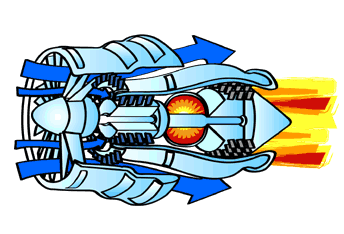jet engine working
Jet engines move the airplane forward with a great force that is produced by a tremendous thrust and causes the plane to fly very fast.
All jet engines, which are also called gas turbines, work on the same principle. The engine sucks air in at the front with a fan. A compressor raises the pressure of the air. The compressor is made with many blades attached to a shaft. The blades spin at high speed and compress or squeeze the air. The compressed air is then sprayed with fuel and an electric spark lights the mixture. The burning gases expand and blast out through the nozzle, at the back of the engine. As the jets of gas shoot backward, the engine and the aircraft are thrust forward. As the hot air is going to the nozzle, it passes through another group of blades called the turbine. The turbine is attached to the same shaft as the compressor. Spinning the turbine causes the compressor to spin.
The image below shows how the air flows through the engine. The air goes through the core of the engine as well as around the core. This causes some of the air to be very hot and some to be cooler. The cooler air then mixes with the hot air at the engine exit area.

This is a picture of how the air flows through an engine
What is Thrust?
Thrust is the forward force that pushes the engine and, therefore, the airplane forward. Sir Isaac Newton discovered that for "every action there is an equal and opposite reaction." An engine uses this principle. The engine takes in a large volume of air. The air is heated and compressed and slowed down. The air is forced through many spinning blades. By mixing this air with jet fuel, the temperature of the air can be as high as three thousand degrees. The power of the air is used to turn the turbine. Finally, when the air leaves, it pushes backward out of the engine. This causes the plane to move forward.
Parts of a Jet Engine

Fan - The fan is the first component in a turbofan. The large spinning fan sucks in large quantities of air. Most blades of the fan are made of titanium. It then speeds this air up and splits it into two parts. One part continues through the "core" or center of the engine, where it is acted upon by the other engine components.
The second part "bypasses" the core of the engine. It goes through a duct that surrounds the core to the back of the engine where it produces much of the force that propels the airplane forward. This cooler air helps to quiet the engine as well as adding thrust to the engine.
Compressor - The compressor is the first component in the engine core. The compressor is made up of fans with many blades and attached to a shaft. The compressor squeezes the air that enters it into progressively smaller areas, resulting in an increase in the air pressure. This results in an increase in the energy potential of the air. The squashed air is forced into the combustion chamber.
Combustor - In the combustor the air is mixed with fuel and then ignited. There are as many as 20 nozzles to spray fuel into the airstream. The mixture of air and fuel catches fire. This provides a high temperature, high-energy airflow. The fuel burns with the oxygen in the compressed air, producing hot expanding gases. The inside of the combustor is often made of ceramic materials to provide a heat-resistant chamber. The heat can reach 2700°.
Turbine - The high-energy airflow coming out of the combustor goes into the turbine, causing the turbine blades to rotate. The turbines are linked by a shaft to turn the blades in the compressor and to spin the intake fan at the front. This rotation takes some energy from the high-energy flow that is used to drive the fan and the compressor. The gases produced in the combustion chamber move through the turbine and spin its blades. The turbines of the jet spin around thousands of times. They are fixed on shafts which have several sets of ball-bearing in between them.
Nozzle - The nozzle is the exhaust duct of the engine. This is the engine part which actually produces the thrust for the plane. The energy depleted airflow that passed the turbine, in addition to the colder air that bypassed the engine core, produces a force when exiting the nozzle that acts to propel the engine, and therefore the airplane, forward. The combination of the hot air and cold air are expelled and produce an exhaust, which causes a forward thrust. The nozzle may be preceded by a mixer, which combines the high temperature air coming from the engine core with the lower temperature air that was bypassed in the fan. The mixer helps to make the engine quieter.



No comments:
Post a Comment